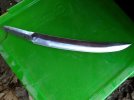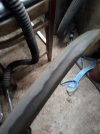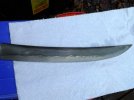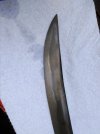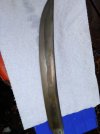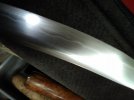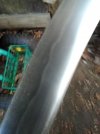That looks really nice Stacy, I like that shape a lot.
Well, don’t laugh at it too much, but below is the rushed and rough finished tanto. Unfortunately I decided not to grind the tip again, even though i know now that it would’ve made it look a lot better. I just didn’t want to open that can of worms, as I’m not good at grinding these tips yet. Definitely on the next one I’ll worry a whole lot more about the geometry.
I also will finish everything better in the future: do engraving on the fittings, finish to a higher luster before blackening, actually get a real silk wrap or at least a better cotton one and more importantly do real wrap (I looked it up but I rushed it big time, the knot is TOTALLY wrong, I know, I just wanted to get it done to see it all, I will be wrapping this better in the near future).
Basically there are a ton of things wrong with it, and I’m aware of most of them. Every fitting has issues, especially the kashiri which I designed (stupidly) on my own without much research. It’s kind of a monstrosity, but for my seventh knife I’m overall pretty happy because at least it’s a functional knife and everything is structurally well made (the blade most importantly).
Thanks a ton for all of the advice and knowledge, especially Stacy; I really learned a LOT doing this knife. I weld and do all types of metal working, but I never brazed something in my life before this. It was an adventure, that’s for sure, and as you can see I didn’t have an easy time of it lol. But all in all it’s mostly done (wrap monstrosity aside, and some finish work I can still do), and I have a lot of new knowledge to work with in the future. To expect much better when people work on this stuff for a lifetime would be a little conceited I think... I can see why it takes a lot of time, and I’m pretty happy that I at least got a knife made. And I couldn’t have done it without Stacy’s help.
I will take it apart to get some better photos one day when I have some more time, I was in a rush here. I have to make the Saya too still clearly.

